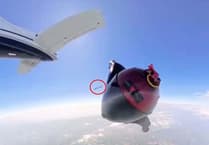HAMPSHIRE and Isle of Wight air ambulance is seeking to warn the public about laser attacks and the threat they pose to the safety of the flying lifesaver.
Since the introduction of night-time operations in January, air ambulance flights has become more susceptible to laser attacks.
An air ambulance spokesman said: “Laser attacks are always sudden, very distracting and can cause temporary visual disturbance for some time after an attack. The consequences of a laser attack can include distraction, temporary flash blindness, and even eye injury. In addition, the human eye is much more sensitive to green light laser, the most common form of laser attack today.”
Although current knowledge and experience suggests the low power levels available to existing hand-held lasers are unlikely to cause permanent eye damage, the threat posed by the availability of higher power lasers in the future should not be discounted.
Alex Lochrane, chief executive of the air ambulance, said: “Aiming a laser at an aircraft can be dangerous for those on board, but it could also mean our lifesaving service is disrupted. Any distractions during a landing, for example, could mean a lifesaving mission is delayed or aborted. It could also distract an on-board medic carrying out critical work on an injured patient.”
In 2010, legislation was introduced which allows offenders to be prosecuted for shining a light at an aircraft in flight so as to dazzle or distract a pilot. According to the Daily Mail, between 2009 and 2015 more than 8,998 laser incidents across the country were reported to the Civil Aviation Authority.
Pressure is currently being put on the government to classify lasers as offensive weapons and so empower police to arrest individuals in possession of a laser without good reason.
Air ambulance pilot Captain Dave Nicholls, who has previous experience of laser attacks while flying, said: “It might seem harmless enough, but a laser shone at a helicopter in the final stages of an approach could easily be enough to cause the pilot to abort a landing.”
Mr Lochrane concluded: “We welcome any new legislation that will protect the safety of our pilots and crew, and ultimately the service that we are able to provide to the community that we serve. While I hope this is never necessary, everyone involved in our lifesaving service would work as closely as possible with the police to apprehend anyone who ever targets our aircraft with a laser.”
The air ambulance flies seven days per week and attends an average of two to three missions a day, many of them lifesaving. The charity receives no government, statutory or national lottery funding for routine operations, and is entirely dependent on donations received from public, companies and grant-making bodies to keep it flying and saving lives.





Comments
This article has no comments yet. Be the first to leave a comment.